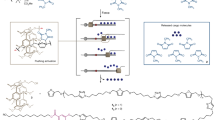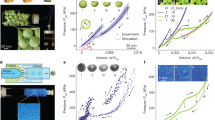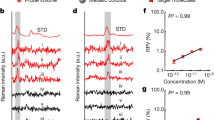Abstract
A previously unexplored property of two-dimensional electronic materials is their ability to graft electronic functionality onto colloidal particles to access local hydrodynamics in fluids to impart mobility and enter spaces inaccessible to larger electronic systems. Here, we demonstrate the design and fabrication of fully autonomous state machines built onto SU-8 particles powered by a two-dimensional material-based photodiode. The on-board circuit connects a chemiresistor circuit element and a memristor element, enabling the detection and storage of information after aerosolization, hydrodynamic propulsion to targets over 0.6 m away, and large-area surface sensing of triethylamine, ammonia and aerosolized soot in inaccessible locations. An incorporated retroreflector design allows for facile position location using laser-scanning optical detection. Such state machines may find widespread application as probes in confined environments, such as the human digestive tract, oil and gas conduits, chemical and biosynthetic reactors, and autonomous environmental sensors.
This is a preview of subscription content, access via your institution
Access options
Access Nature and 54 other Nature Portfolio journals
Get Nature+, our best-value online-access subscription
$29.99 / 30 days
cancel any time
Subscribe to this journal
Receive 12 print issues and online access
$259.00 per year
only $21.58 per issue
Buy this article
- Purchase on Springer Link
- Instant access to full article PDF
Prices may be subject to local taxes which are calculated during checkout






Similar content being viewed by others
References
Lou, Z., Liang, Z. & Shen, G. Photodetectors based on two dimensional materials. J. Semicond. 37, 091001 (2016).
Chhowalla, M., Jena, D. & Zhang, H. Two-dimensional semiconductors for transistors. Nature 1, 16052 (2016).
Varghese, S., Varghese, S., Swaminathan, S., Singh, K. & Mittal, V. Two-dimensional materials for sensing: graphene and beyond. Electronics 4, 651 (2015).
Yuan, J. & Lou, J. 2D materials: memristor goes two-dimensional. Nat. Nanotech. 10, 389–390 (2015).
Zhang, X., Hou, L., Ciesielski, A. & Samorì, P. 2D materials beyond graphene for high-performance energy storage applications. Adv. Energy Mater. 6, 1600671 (2016).
Khorasani, S. & Koottandavida, A. Nonlinear graphene quantum capacitors for electro-optics. 2D Mater. Appl. 1, 7 (2017).
Kaewsaneha, C., Tangboriboonrat, P., Polpanich, D. & Elaissari, A. Multifunctional fluorescent-magnetic polymeric colloidal particles: preparations and bioanalytical applications. ACS Appl. Mater. Interfaces 7, 23373–23386 (2015).
Kamaly, N., Yameen, B., Wu, J. & Farokhzad, O. C. Degradable controlled-release polymers and polymeric nanoparticles: mechanisms of controlling drug release. Chem. Rev. 116, 2602–2663 (2016).
Udo, S. Stochastic thermodynamics, fluctuation theorems and molecular machines. Rep. Progress Phys. 75, 126001 (2012).
Velegol, D. Assembling colloidal devices by controlling interparticle forces. Proc. SPIE 1, 25 (2007).
Spellings, M. et al. Shape control and compartmentalization in active colloidal cells. Proc. Natl Acad. Sci. USA 112, 4642 (2015).
Yao, J. et al. Nanowire nanocomputer as a finite-state machine. Proc. Natl Acad. Sci. USA 111, 2431–2435 (2014).
Ding, T. et al. Light-induced actuating nanotransducers. Proc. Natl Acad. Sci. USA 113, 5503–5507 (2016).
Funke, D. A. et al. A 200 μm by 100 μm smart dust system with an average current consumption of 1.3 nA. IEEE Proc. ICECS 2016 1, 512–515 (2016).
Taniguchi, M. & Kawai, T. DNA electronics. Physica E 33, 1–12 (2006).
Siuti, P., Yazbek, J. & Lu, T. K. Engineering genetic circuits that compute and remember. Nat. Protoc. 9, 1292–1300 (2014).
Kamm, R. D. & Bashir, R. Creating living cellular machines. Ann. Biomed. Eng. 42, 445–459 (2014).
Roquet, N., Soleimany, A. P., Ferris, A. C., Aaronson, S. & Lu, T. K. Synthetic recombinase-based state machines in living cells. Science 353, aad8559 (2016).
Hansen, M. C. & Loveland, T. R. A review of large area monitoring of land cover change using Landsat data. Remote Sens. Environ. 122, 66–74 (2012).
Seo, D. et al. Wireless recording in the peripheral nervous system with ultrasonic neural dust. Neuron 91, 529–539 (2016).
Ferrari, S. et al. Latest advances in the manufacturing of 3D rechargeable lithium microbatteries. J. Power Sources 286, 25–46 (2015).
Seo, D., Carmena, J. M., Rabaey, J. M., Maharbiz, M. M. & Alon, E. Model validation of untethered, ultrasonic neural dust motes for cortical recording. J. Neurosci. Methods 244, 114–122 (2015).
Kim, H. & Kim, M. J. Electric field control of bacteria-powered microrobots using a static obstacle avoidance algorithm. IEEE Trans. Robot. 32, 125–137 (2016).
Servant, A., Qiu, F., Mazza, M., Kostarelos, K. & Nelson, B. J. Controlled in vivo swimming of a swarm of bacteria-like microrobotic flagella. Adv. Mater. 27, 2981–2988 (2015).
Ionescu, A. M. & Riel, H. Tunnel field-effect transistors as energy-efficient electronic switches. Nature 479, 329–337 (2011).
Fiori, G. et al. Electronics based on two-dimensional materials. Nat. Nanotech. 9, 768–779 (2014).
Salvatore, G. A. et al. Wafer-scale design of lightweight and transparent electronics that wraps around hairs. Nat. Commun. 5, 2982 (2014).
Akinwande, D., Petrone, N. & Hone, J. Two-dimensional flexible nanoelectronics. Nat. Commun. 5, 5678 (2014).
Fang, H. et al. Strong interlayer coupling in van der Waals heterostructures built from single-layer chalcogenides. Proc. Natl Acad. Sci. USA 111, 6198–6202 (2014).
Cheng, R. et al. Electroluminescence and photocurrent generation from atomically sharp WSe2/MoS2 heterojunction p–n diodes. Nano Lett. 14, 5590–5597 (2014).
Ye, L., Li, H., Chen, Z. & Xu, J. Near-infrared photodetector based on MoS2/black phosphorus heterojunction. ACS Photon. 3, 692–699 (2016).
Perkins, F. K. et al. Chemical vapor sensing with monolayer MoS2. Nano Lett. 13, 668–673 (2013).
Mouri, S., Miyauchi, Y. & Matsuda, K. Tunable photoluminescence of monolayer MoS2 via chemical doping. Nano Lett. 13, 5944–5948 (2013).
Hao, C. et al. Liquid-exfoliated black phosphorous nanosheet thin films for flexible resistive random access memory applications. Adv. Funct. Mater. 26, 2016–2024 (2016).
Wang, W. et al. MoS2 memristor with photoresistive switching. Sci. Rep. 6, 31224 (2016).
Sangwan, V. K. et al. Gate-tunable memristive phenomena mediated by grain boundaries in single-layer MoS2. Nat. Nanotech. 10, 403–406 (2015).
Bessonov, A. A. et al. Layered memristive and memcapacitive switches for printable electronics. Nat. Mater. 14, 199–204 (2015).
Lillesand, T., Kiefer, R. W. & Chipman, J. in Remote Sensing and Image Interpretation 1–59 (Wiley, New York, NY, 2014).
Brunete, A., Hernando, M., Torres, J. E. & Gambao, E. Heterogeneous multi-configurable chained microrobot for the exploration of small cavities. Autom. Constr. Magaz. 21, 184–198 (2012).
Murvay, P.-S. & Silea, I. A survey on gas leak detection and localization techniques. J. Loss Prev. Process Ind. 25, 966–973 (2012).
Rajtar, J. M. & Muthiah, R. Pipeline leak detection system for oil and gas flowlines. J. Manufact. Sci. Eng. 119, 105–109 (1997).
Gavrilescu, M. & Tudose, R. Z. Residence time distribution of the liquid phase in a concentric-tube airlift reactor. Chem. Eng. Process. 38, 225–238 (1999).
Kurt, S. K., Gelhausen, M. G. & Kockmann, N. Axial dispersion and heat transfer in a milli/microstructured coiled flow inverter for narrow residence time distribution at laminar flow. Chem. Eng. Tech. 38, 1122–1130 (2015).
Tan, X., Sun, Z. & Akyildiz, I. F. Wireless underground sensor networks: MI-based communication systems for underground applications. IEEE Antennas Propag. 57, 74–87 (2015).
Yamate, T., Fujisawa, G. & Ikegami, T. Optical sensors for the exploration of oil and gas. J. Light. Technol. 35, 3538–3545 (2017).
Kalantar-Zadeh, K. et al. A human pilot trial of ingestible electronic capsules capable of sensing different gases in the gut. Nat. Electron. 1, 79–87 (2018).
Costello, B. P. J. d. L., Ledochowski, M. & Ratcliffe, N. M. The importance of methane breath testing: a review. J. Breath. Res. 7, 024001 (2013).
Farra, R. et al. First-in-human testing of a wirelessly controlled drug delivery microchip. Sci. Transl. Med. 4, 122ra21 (2012).
Timmer, B., Olthuis, W. & Berg, A. Ammonia sensors and their applications—a review. Sens. Actuat. B 107, 666–677 (2005).
Nielsen, A. (ed.) in Ammonia: Catalysis and Manufacture (ed. Nielsen, A.) 329–346 (Springer, Berlin, 1995).
Cho, B. et al. Charge-transfer-based gas sensing using atomic-layer MoS2. Sci. Rep. 5, 8052 (2015).
Bernstein, J. A. et al. Health effects of air pollution. J. Allergy Clin. Immunol. 114, 1116–1123 (2004).
Derbyshire, E. Natural minerogenic dust and human health. AMBIO 36, 73–77 (2007).
Grob, B., Schmid, J., Ivleva, N. P. & Niessner, R. Conductivity for soot sensing: possibilities and limitations. Anal. Chem. 84, 3586–3592 (2012).
Switkes, M., Ervin, B. L., Kingsborough, R. P., Rothschild, M. & Sworin, M. Retroreflectors for remote readout of colorimetric sensors. Sens. Actuat. B 160, 1244–1249 (2011).
Yu, Y. et al. Controlled scalable synthesis of uniform, high-quality monolayer and few-layer MoS2 films. Sci. Rep. 3, 1866 (2013).
Gurarslan, A. et al. Surface-energy-assisted perfect transfer of centimeter-scale monolayer and few-layer MoS2 films onto arbitrary substrates. ACS Nano 8, 11522–11528 (2014).
Acknowledgements
This work was funded by a 2015 US Office of Naval Research Multi University Research Initiative (MURI) grant on Foldable and Adaptive Two-Dimensional Electronics (FATE) at MIT, Harvard and University of Southern California. V.B.K. is supported by The Swiss National Science Foundation (projects nos P2ELP3_162149 and P300P2_174469). Microfabrication for this work was performed at the Harvard University Center for Nanoscale Systems (CNS), a member of the National Nanotechnology Coordinated Infrastructure Network (NNCI), which is supported by the National Science Foundation under NSF award no. 1541959. D.K. is supported by a Grant-in-Aid for JSPS Fellows (JSPS KAKENHI grant no. 15J07423) and Encouragement of Young Scientists (B) (JSPS KAKENHI grant no. JP16K17485) from the Japan Society for the Promotion of Science.
Author information
Authors and Affiliations
Contributions
V.B.K. and M.S.S. conceived the idea and planned experiments with the assistance of P.L., D.K. and A.T.L. V.B.K. fabricated samples, performed experimental measurements, and analysed data with the assistance of P.L. and D.K. V.B.K. and J.A.L. fabricated 2D materials with inputs from Y.S., P.L. and D.K. V.B.K., A.L.C. and M.S.S. wrote the manuscript with inputs from all the authors. All authors contributed to discussions informing the research.
Corresponding author
Ethics declarations
Competing interests
The authors declare no competing interests.
Additional information
Publisher’s note: Springer Nature remains neutral with regard to jurisdictional claims in published maps and institutional affiliations.
Supplementary Information
Supplementary Information
Supplementary Figures 1–18, Supplementary References
Rights and permissions
About this article
Cite this article
Koman, V.B., Liu, P., Kozawa, D. et al. Colloidal nanoelectronic state machines based on 2D materials for aerosolizable electronics. Nature Nanotech 13, 819–827 (2018). https://doi.org/10.1038/s41565-018-0194-z
Received:
Accepted:
Published:
Issue Date:
DOI: https://doi.org/10.1038/s41565-018-0194-z
This article is cited by
-
Image-based vegetation analysis of desertified area by using a combination of ImageJ and Photoshop software
Environmental Monitoring and Assessment (2024)
-
Colloidal robotics
Nature Materials (2023)
-
The rise of two-dimensional tellurium for next-generation electronics and optoelectronics
Frontiers of Physics (2023)
-
High-mobility patternable MoS2 percolating nanofilms
Nano Research (2021)
-
A conceptual advance that gives microrobots legs
Nature (2020)



